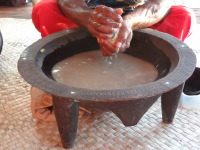What is kava?
The kava plant is a member of the black pepper family (Piper methysticum) which is traditionally used in the South Pacific to make a psychotropic drink consumed in cultural ceremonies and also socially - the drink is also called kava [1–3].
Kava is made by infusing the dried roots of the kava plant in water, or less commonly, in coconut milk. [two].
 |
 |
 |
|
Kava leaves Forest and Kim Starr |
Mark Heard's kava root on Flickr | Preparing kava by Dave Lonsdale on Flickr |
What is kava? dermopathy?
Kava dermopathy is a skin condition that occurs in patients who regularly consume kava [1]. In Fiji, kava dermopathy is known as kanikani. [2], while in Australia it is also known as crocodile skin [4].
Kava dermopathy

Ichthyosis acquired in kava trough
Who gets kava skin disease?
Kava dermopathy occurs in people who are heavy or heavy users of kava [2,3].
It occurs most commonly in the South Pacific and the indigenous population of northern Australia. [4].
What causes kava dermopathy?
The cause of kava dermopathy is unknown; However, there are many hypotheses that include [2]:
- Interference with cholesterol metabolism
- Accumulation of kavalactones or flavopigments
- Allergic systemic Contact dermatitis
- Defective cytochrome P450 enzymes [4].
What are the clinical characteristics of kava dermopathy?
- the eruption of kava dermopathy often begins on the head, face, and neck, and gradually becomes more generalized [4].
- The rash is ichthyosiform (similar to ichthyosis); that is, rough, dry and scaly.
- The scales are polygonal fit.
- The rash lacks erythema [2].
- It may be more evident in areas of skin exposed to the sun. [3].
- There are often associates palmoplantar keratoderma [2].
- Facial swelling and hair loss can also occur [3].
- Some patients complain of redness.
- Kava dermopathy may have an associated peripheral neuropathy, which produces numbness or tingling in the hands and feet.
How is kava dermopathy diagnosed?
Kava dermopathy is usually a clinical diagnosis, taking into account physical characteristics and history, including a history of regular kava use, in addition to resolution of the rash in the cessation of kava consumption [4].
Which is the differential diagnosis for kava dermopathy?
Other ichthyotic disorders may appear similar to kava dermopathy. Ichthyotic disorders can be distinguished according to the patient's history.
Hereditary ichthyosis generally occurs at a much younger age and can be congenital (eg, ichthyosis vulgaris and X-linked recessive ichthyosis).
Other causes of acquired ichthyosis include [5]:
- Malignancy
- Vitamin abnormality and lipid absorption
- Medications (eg, cholesterol-lowering medications, nicotinic acid)
- Infections, such as the human immunodeficiency virus (HIV), leprosy, human T cell lymphotropic virus type 1 (HTLV-1).
What is the treatment for kava skin disease?
Kava dermopathy clears up when kava consumption is stopped [3,4].
General measures to manage the rash include:
- Soap-free cleaner
- Emollients and keratolytics, such as urea cream.
What is the result of kava dermopathy?
Continued kava consumption will result in the persistence and likely progression of kava skin disease.
